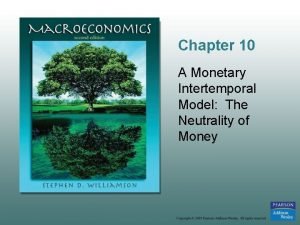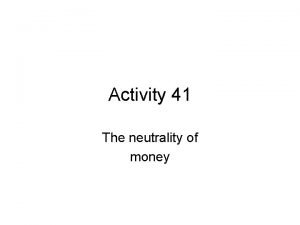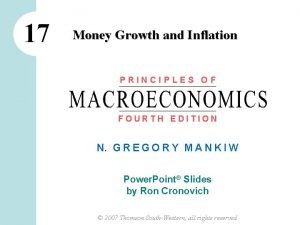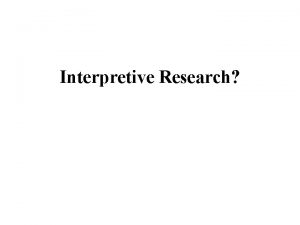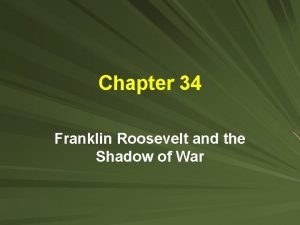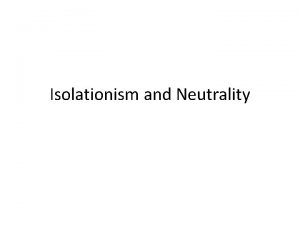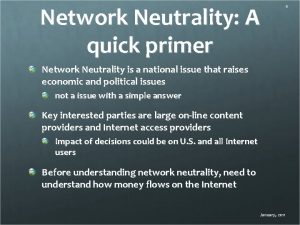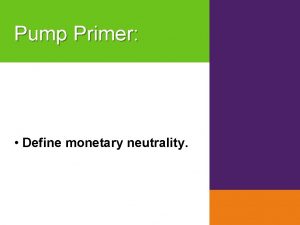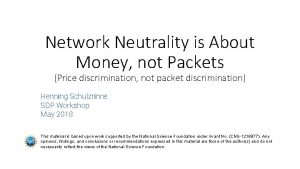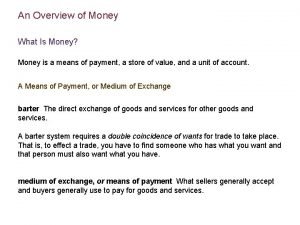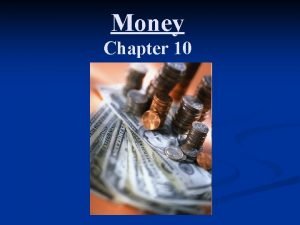Activity 41 The neutrality of money Money is


















- Slides: 18

Activity 41 The neutrality of money

Money is neutral • In the long run changes in money supply will only change price level and have no change on real output

Suppose that initially the economy is at the intersection of AD and SRAS, and the Fed decides to implement an expansionary policy to increase the level of employment SRAS PRICE LEVEL LRAS AD REAL GDP • In the short run, explain what happens to real output.

Suppose that initially the economy is at the intersection of AD and SRAS, and the Fed decides to implement an expansionary policy to increase the level of employment SRAS PRICE LEVEL LRAS AD 1 AD REAL GDP • In the short run, explain what happens to real output. • REAL OUTPUT SHOULD GROW • With the decrease in interest rates because of increased MS, the interest rate sensitive components of aggregate demand (consumption and investment) will increase thereby increasing output

Suppose that initially the economy is at the intersection of AD and SRAS, and the Fed decides to implement an expansionary policy to increase the level of employment SRAS PRICE LEVEL LRAS AD REAL GDP • In the short run, explain what happens to the price level.

Suppose that initially the economy is at the intersection of AD and SRAS, and the Fed decides to implement an expansionary policy to increase the level of employment PRICE LEVEL LRAS SRAS AD 1 AD REAL GDP • In the short run, explain what happens to the price level. • PRICE LEVEL WILL INCREASE • An increase in demand can only be met if firms have an incentive to increase production. A price increase provides that incentive

Suppose that initially the economy is at the intersection of AD and SRAS, and the Fed decides to implement an expansionary policy to increase the level of employment SRAS PRICE LEVEL LRAS AD REAL GDP • In the short run, explain what happens to employment and nominal wages.

Suppose that initially the economy is at the intersection of AD and SRAS, and the Fed decides to implement an expansionary policy to increase the level of employment PRICE LEVEL LRAS SRAS AD 1 AD REAL GDP • In the short run, explain what happens to employment and nominal wages. • EMPLOYMENT WILL INCREASE WHILE NOMINAL WAGES REMAIN UNCHANGED. • Firms need to hire more labor to increase output while workers do not yet realize that price level has risen

Suppose that initially the economy is at the intersection of AD and SRAS, and the Fed decides to implement an expansionary policy to increase the level of employment SRAS PRICE LEVEL LRAS AD REAL GDP • In the short run, explain what happens to nominal interest rates and real interest rates.

Suppose that initially the economy is at the intersection of AD and SRAS, and the Fed decides to implement an expansionary policy to increase the level of employment • LRAS SRAS • PRICE LEVEL • • AD 1 AD REAL GDP In the short run, explain what happens to nominal interest rates and real interest rates. BOTH THE NOMINAL AND THE REAL INTEREST RATES DECLINE The increase in money supply causes nominal rates to initially decline while demand for money is constant The real interest rate (which had been equal to the nominal interest rate with no inflation) now declines because of the decrease in nominal interest rates and increase in price level Real = nominal (down) – inflation (up)

Suppose that initially the economy is at the intersection of AD and SRAS, and the Fed decides to implement an expansionary policy to increase the level of employment SRAS PRICE LEVEL LRAS AD REAL GDP • In the long run, explain what happens to real output.

Suppose that initially the economy is at the intersection of AD and SRAS, and the Fed decides to implement an expansionary policy to increase the level of employment LRAS SRAS 1 PRICE LEVEL SRAS AD 1 AD REAL GDP • In the long run, explain what happens to real output. • REAL OUTPUT RETURNS TO THE FULL EMPLOYMENT LEVEL • As workers recognize the increased price level, they demand get wage increases. This in turn increases production costs and short run aggregate supply decreases

Suppose that initially the economy is at the intersection of AD and SRAS, and the Fed decides to implement an expansionary policy to increase the level of employment SRAS PRICE LEVEL LRAS AD REAL GDP • In the long run, explain what happens to the price level.

Suppose that initially the economy is at the intersection of AD and SRAS, and the Fed decides to implement an expansionary policy to increase the level of employment LRAS SRAS 1 PRICE LEVEL SRAS AD 1 AD REAL GDP • In the long run, explain what happens to the price level. • PRICE LEVEL REMAINS HIGH • Nominal wages are now in alignment with the higher price level

Suppose that initially the economy is at the intersection of AD and SRAS, and the Fed decides to implement an expansionary policy to increase the level of employment SRAS PRICE LEVEL LRAS AD REAL GDP • In the long run, explain what happens to employment and nominal wages.

Suppose that initially the economy is at the intersection of AD and SRAS, and the Fed decides to implement an expansionary policy to increase the level of employment LRAS SRAS 1 PRICE LEVEL SRAS AD 1 AD REAL GDP • In the long run, explain what happens to employment and nominal wages. • EMPLOYMENT IS AT THE FULL EMPLOYMENT LEVEL AND NOMINAL WAGES HAVE RISEN • Nominal wages rise so that real wages given them the same purchasing power

Suppose that initially the economy is at the intersection of AD and SRAS, and the Fed decides to implement an expansionary policy to increase the level of employment SRAS PRICE LEVEL LRAS AD REAL GDP • In the long run, explain what happens to the nominal interest rate and the real interest rate.

Suppose that initially the economy is at the intersection of AD and SRAS, and the Fed decides to implement an expansionary policy to increase the level of employment SRAS PRICE LEVEL LRAS AD REAL GDP • In the long run, explain what happens to the nominal interest rate and the real interest rate. • The real interest rate returns to its normal level (in the US between 2% and 3%). Nominal rates rise to include the inflation rate and the real interest rate
 Monetary intertemporal model
Monetary intertemporal model Money neutrality
Money neutrality Money neutrality
Money neutrality Dana damian
Dana damian Well defined
Well defined Wilson neutrality
Wilson neutrality Empathic neutrality
Empathic neutrality Accounting framework
Accounting framework Wilson neutrality
Wilson neutrality Net neutrality
Net neutrality Neutrality acts 1935-37
Neutrality acts 1935-37 How is daisy described in the great gatsby
How is daisy described in the great gatsby Gatsby historical background
Gatsby historical background Old money aesthetic
Old money aesthetic Money smart money match
Money smart money match Money on money multiple
Money on money multiple Tư thế ngồi viết
Tư thế ngồi viết Thế nào là giọng cùng tên? *
Thế nào là giọng cùng tên? * Thể thơ truyền thống
Thể thơ truyền thống
